
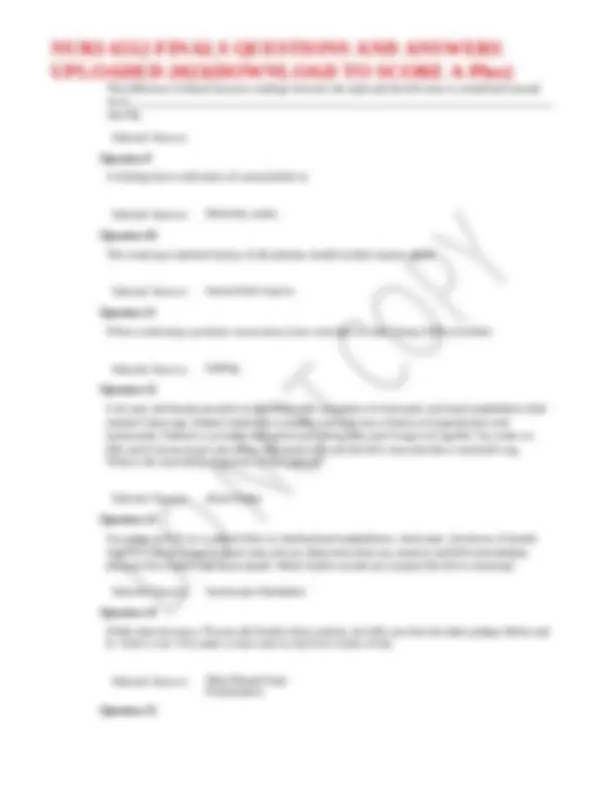
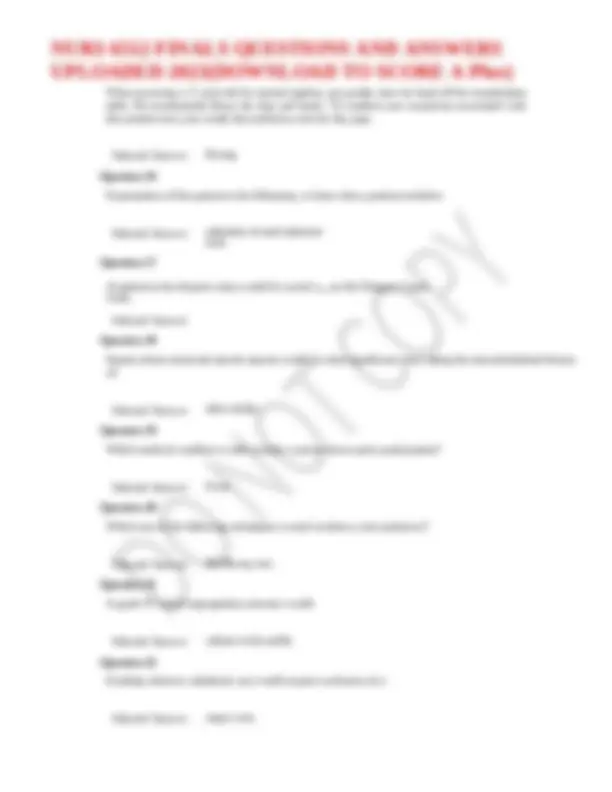

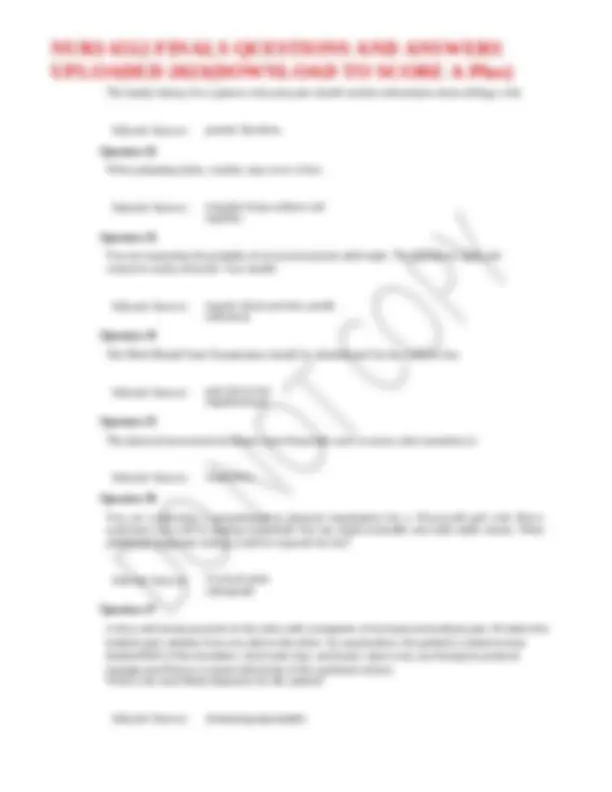

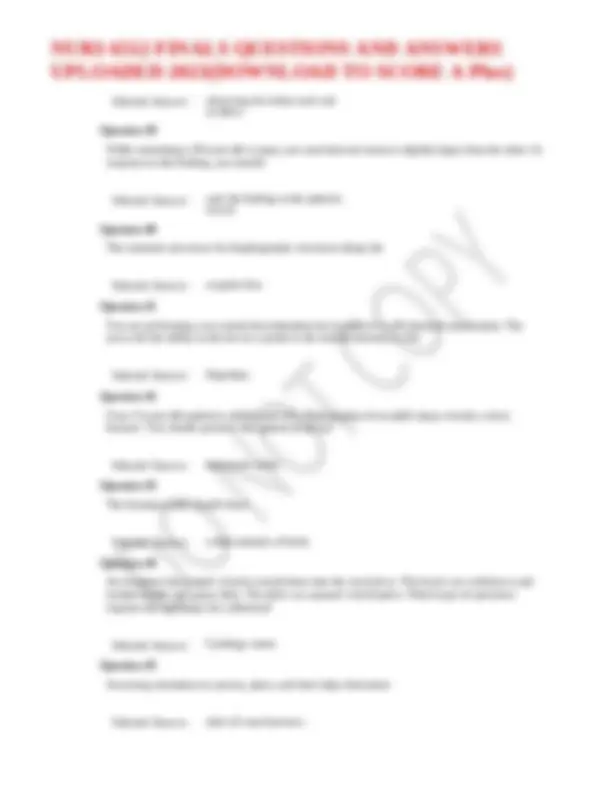

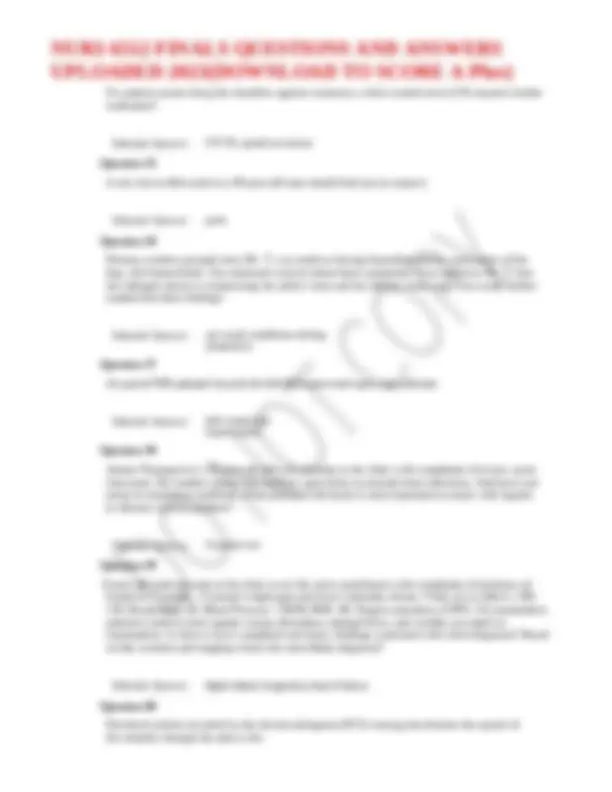



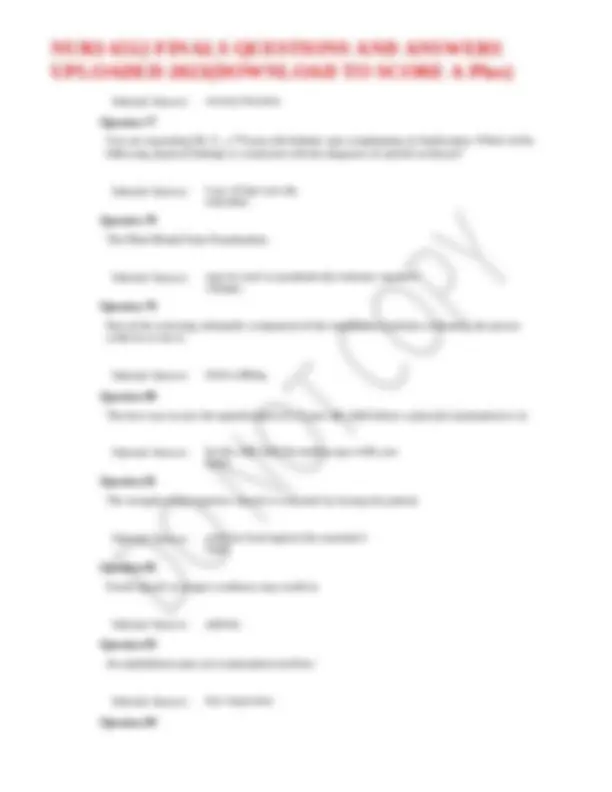

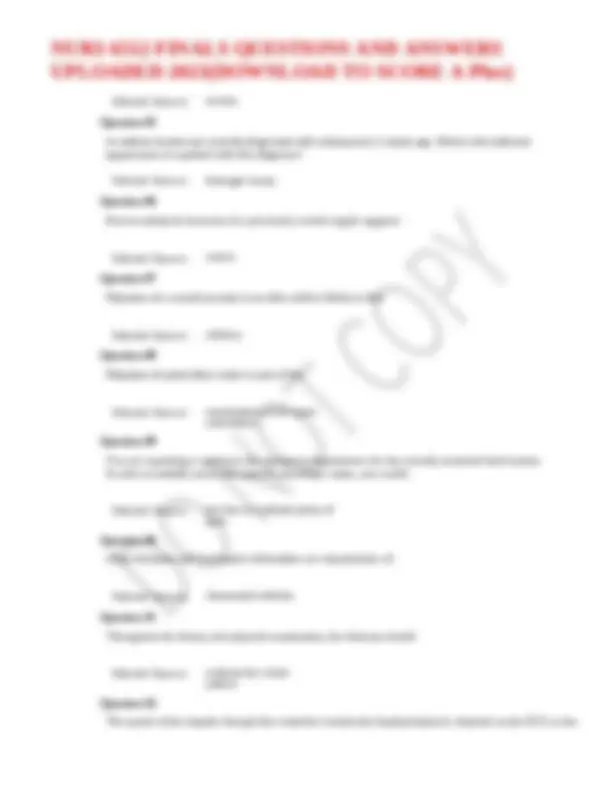





Study with the several resources on Docsity

Earn points by helping other students or get them with a premium plan


Prepare for your exams
Study with the several resources on Docsity

Earn points to download
Earn points by helping other students or get them with a premium plan
Community
Ask the community for help and clear up your study doubts
Discover the best universities in your country according to Docsity users
Free resources
Download our free guides on studying techniques, anxiety management strategies, and thesis advice from Docsity tutors
NURS 6512 FINALS QUESTIONS AND ANSWERS UPLOADED 2023NURS 6512 FINALS QUESTIONS AND ANSWERS UPLOADED 2023NURS 6512 FINALS QUESTIONS AND ANSWERS UPLOADED 2023NURS 6512 FINALS QUESTIONS AND ANSWERS UPLOADED 2023NURS 6512 FINALS QUESTIONS AND ANSWERS UPLOADED 2023NURS 6512 FINALS QUESTIONS AND ANSWERS UPLOADED 2023
Typology: Exams
1 / 25

This page cannot be seen from the preview
Don't miss anything!


















Question 1 You are conducting an examination of Mr. Curtis's heart and blood vessels and auscultate a grade III murmur. The intensity of this murmur is: Selected Answer: moderately^ loud. Question 2 Nerves that arise from the brain rather than the spinal cord are called: Selected Answer: cranial. Question 3 The checkout station for preparticipation physical evaluation (PPE) is critical because at this point: Selected Answer: coordination^ of^ follow-ups is reviewed. Question 4 Temporalis and masseter muscles are evaluated by: Selected Answer: having the^ patient clench his^ or^ her teeth. Question 5 To assess a cremasteric reflex, the examiner strokes the: Selected Answer: inner^ thigh and^ observes^ whether^ the testicle^ and^ scrotum^ rise^ on the stroked side. Question 6 As Mr. B. enters the room, you observe that his gait is wide based and he staggers from side to side while swaying his trunk. You would document Mr. B.'s pattern as: Selected Answer: cerebellar^ ataxia. Question 7 The goals of preparticipation sports evaluation include: Selected Answer: identifying^ risk^ of^ injury^ or^ death^ during^ sports participation.
Question 8
When assessing a 17-year-old for nuchal rigidity, you gently raise his head off the examination table. He involuntarily flexes his hips and knees. To confirm your suspicions associated with this positive test, you would also perform a test for the sign. Selected Answer: Kernig Question 16 Examination of the patient in the lithotomy, or knee-chest, position includes: Selected Answer: palpation of^ anal sphincter tone. Question 17 A patient in the deepest coma would be scored a on the Glasgow Coma Scale. Selected Answer: Question 18 Inquiry about nocturnal muscle spasms would be most significant when taking the musculoskeletal history of: Selected Answer: older^ adults. Question 19 Which medical condition would exclude a person from sports participation? Selected Answer: Fever Question 20 Which one of the following techniques is used to detect a torn meniscus? Selected Answer: McMurray^ test Question 21 A grade IV mitral regurgitation murmur would: Selected Answer: radiate to^ the axilla. Question 22 If pitting edema is unilateral, you would suspect occlusion of a: Selected Answer: major^ vein.
Question 23
Question 31
The family history for a patient with joint pain should include information about siblings with: Selected Answer: genetic^ disorders. Question 32 When palpating joints, crepitus may occur when: Selected Answer: irregular^ bony^ surfaces^ rub together. Question 33 You are inspecting the genitalia of an uncircumcised adult male. The foreskin is tight and cannot be easily retracted. You should: Selected Answer: inquire^ about^ previous^ penile infections. Question 34 The Mini-Mental State Examination should be administered for the patient who: Selected Answer: gets^ lost^ in her neighborhood. Question 35 The physical assessment technique most frequently used to assess joint symmetry is: Selected Answer: inspection. Question 36 You are conducting a preparticipation physical examination for a 10-year-old girl with Down syndrome who will be playing basketball. She has slight torticollis and mild ankle clonus. What additional diagnostic testing would be required for her? Selected Answer: Cervical^ spine radiograph Question 37 A 40 yr old female presents to the clinic with complaints of low back and buttock pain. Pt states the buttock pain radiates from one side to the other. On examination, the patient is noted to have limited ROM of the shoulders, chest wall, hips, and knees. Upon xray, you find gross postural changes and there is a severe deformity of the vertebral column. What is the most likely diagnosis for this patient? Selected Answer: Ankylosing Spondylitis
Selected Answer: observing^ the^ infant^ suck and swallow. Question 39 While examining a 30-year-old woman, you note that one breast is slightly larger than the other. In response to this finding, you should: Selected Answer: note^ the^ finding^ in^ the^ patient's record. Question 40 The examiner percusses for diaphragmatic excursion along the: Selected Answer: scapular line. Question 41 You are performing a two-point discrimination test as part of a well physical examination. The area with the ability to discern two points in the shortest distance is the: Selected Answer: fingertips. Question 42 Your 15-year-old patient is athletic and thin. Radiography of an ankle injury reveals a stress fracture. You should question this patient about her: Selected Answer: menstrual^ cycles. Question 43 The foramen ovale should close: Selected Answer: within^ minutes of^ birth. Question 44 An examiner has rotated a brush several times into the cervical os. The brush was withdrawn and stroked lightly on a glass slide. The slide was sprayed with fixative. Which type of specimen requires this technique for collection? Selected Answer: Cytology smear Question 45 Assessing orientation to person, place, and time helps determine: Selected Answer: state^ of^ consciousness.
Question 46
Selected Answer: whether^ a child^ is^ developing^ as expected. Question 54
If a patient cannot shrug the shoulders against resistance, which cranial nerve (CN) requires further evaluation? Selected Answer: CN XI,^ spinal^ accessory Question 55 A red, hot swollen joint in a 40-year-old man should lead you to suspect: Selected Answer: gout. Question 56 During a routine prenatal visit, Ms. T. was noted as having dependent edema, varicosities of the legs, and hemorrhoids. She expressed concern about these symptoms. You explain to Ms. T. that her enlarged uterus is compressing her pelvic veins and her inferior vena cava. You would further explain that these findings: Selected Answer: are usual^ conditions^ during pregnancy. Question 57 An apical PMI palpated beyond the left fifth intercostal space may indicate: Selected Answer: left^ ventricular hypertrophy. Question 58 Adrian Thompson is a 19-year-old girl who presents to the clinic with complaints of severe, acute chest pain. Her mother reports that Andrian, apart from occasional sinus infections, Andrian is not prone to respiratory problems. What potential risk factor is most important to assess with regards to Adrian's current problem? Selected Answer: Cocaine^ use Question 59 6-year-old male presents to the clinic to see the nurse practitioner with complaints of shortness of breath for 1 months, 15-pound weight gain and lower extremity edema. Vitals are as follows: HR: 120, Respirations 30, Blood Pressure: 138/90, BMI: 40; Oxygen saturation of 90%. On examination patient is noted to have jugular venous distention, enlarged liver, and crackles are noted on examination. A chest x-ray is completed and shows findings consistent with which diagnosis? Based on this scenario and imaging what is the most likely diagnosis? Selected Answer: Right Sided Congestive Heart Failure Question 60 Electrical activity recorded by the electrocardiogram (ECG) tracing that denotes the spread of the stimulus through the atria is the:
Adrian Thomas is a 19-year-old girl who presents to the clinic with complaints of severe, acute chest pain. Her father reports that Adrian, apart from occasional sinus infections, Adrian is not prone to respiratory problems. What potential risk factor is most important to assess with regards to Adrian's current problem? Selected Answer: Cocaine^ use Question 62 When you attempt to move a 10-month-old child from his mother's lap to the examination table, he screams loudly. Your best action is to: Selected Answer: perform^ the examination^ while the^ child^ is^ in^ the mother's lap. Question 63 A cervical polyp usually appears as a: Selected Answer: bright-red^ soft^ protrusion from^ the endocervical canal. Question 64 You are conducting a clinical breast examination for your 30-year-old patient. Her breasts are symmetrical with bilateral, multiple tender masses that are freely moveable with well-defined borders. You recognize that these symptoms and assessment findings are consistent with: Selected Answer: fibrocystic^ changes. Question 65 Functional assessment is most important during the examination of a(n): Selected Answer: older^ adult. Question 66 A positive straight leg raise test usually indicates: Selected Answer: lumbar^ nerve^ root irritation. Question 67 Inspection of the scrotum should reveal: Selected Answer: left^ scrotal sac lower^ than^ the right. Question 68 One of the most important aspects to consider in the orthopedic screening examination is:
Selected Answer: symmetry.
When assessing superficial pain, touch, vibration, and position perceptions, you are testing:
Selected Answer: sensory function. Question 77 You are examining Mr. S., a 79-year-old diabetic man complaining of claudication. Which of the following physical findings is consistent with the diagnosis of arterial occlusion? Selected Answer: Loss^ of^ hair^ over^ the extremity Question 78 The Mini-Mental State Examination: Selected Answer: may^ be used^ to quantitatively^ estimate cognitive changes. Question 79 Part of the screening orthopedic component of the examination includes evaluating the person while he or she is: Selected Answer: duck^ walking. Question 80 The best way to ease the apprehension of a 3-year-old child before a physical examination is to: Selected Answer: let^ the child^ hold^ the^ stethoscope^ while you listen. Question 81 The strength of the trapezius muscle is evaluated by having the patient: Selected Answer: push her^ head against the^ examiner's hand. Question 82 Facial muscle or tongue weakness may result in: Selected Answer: aphasia. Question 83 An ophthalmoscopic eye examination involves: Selected Answer: lens^ inspection. Question 84